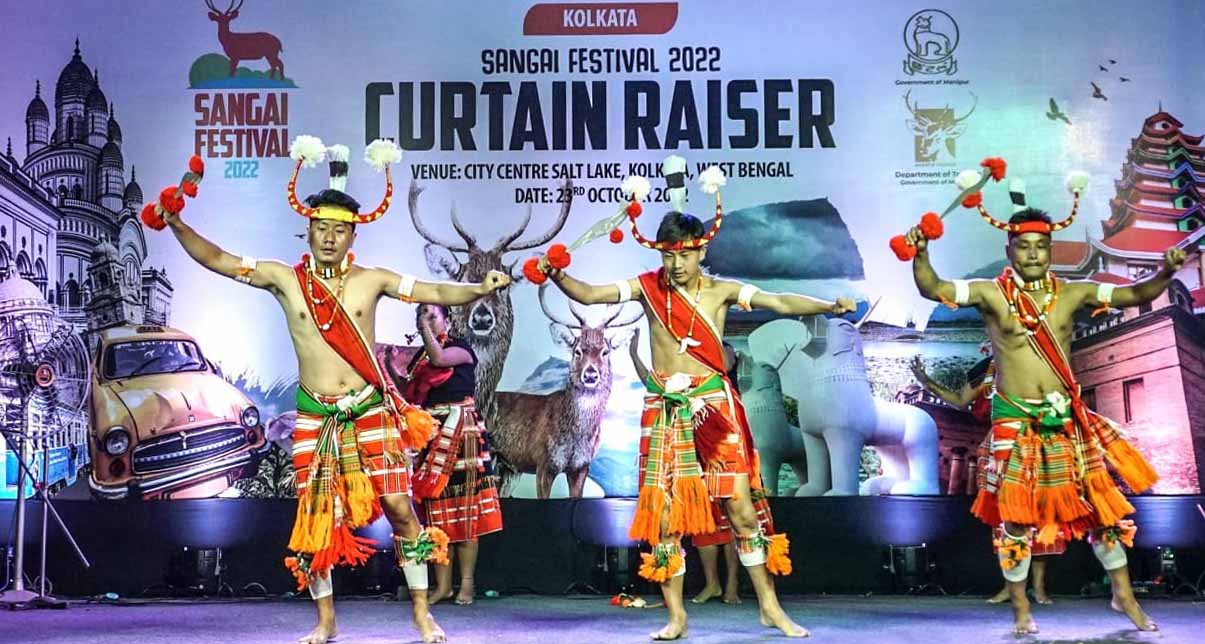The annual Sangai Festival of Manipur just around the corner after a two-year hiatus on account of the COVID pandemic which devastated the state as it did the rest of the country and the world. The 10-day festival will conclude on the last day of November and on the very next day, the Hornbill Festival of neighbouring Nagaland will begin. It is curious that the two festivals dovetail each other, probably a coincidence, but nonetheless in happy serendipity making it seem deliberately fashioned to benefit together by the proximity.
For any traditional and agrarian society, end of harvest is time for celebration and relaxation before hard work for the next crop cycle begins. It may be recalled besides Sangai and Hornbill festivals, there was also several other celebrations of the same season amongst the different tribes and communities of the state, including Kut of the Chin-Kukis in the beginning of November. The explanatory background of these festivals aside, what we are concerned here is the manner in which Sangai festival and Hornbill festival are often pitted as rivals, just as Manipur and Nagaland are also often pitted similarly. This in our opinion is a false binary for without our knowing it, the two festivals are actually partners, complimenting each other. They are different in many ways, but the differences also help enrich this partnership and make them even more meaningful. In fact, we would even suggest the two state governments to put their heads together to sell the two festivals together. To use the analogy of a familiar marketing promotion line, “buy and get one free”, this would be like telling putative visitors that if they go to one, the other is a step way and can be had in one trip. Moreover, what the visitors get will be a more composite picture of the sub-region, and it is this composite picture which the two states together in partnership can sell, and undoubtedly such a strategy would open up a bigger market than each selling their half only. We already have proofs of this. Many who have been covering Sangai festival would have come across foreign visitors who come here with also an aim to go from here to Kisama, the venue of the Hornbill festival.
The two are different and indeed offer very different attractions for tourists. In terms of exotic value, it must be said Hornbill is much better known in the world outside the Northeast. The atavistic charm of the different tribes in their tradition costumes is irresistible for photographers too, and many of these photographs make it to the pages of different publications, national and international, much more than pictures from Sangai festival have done. A google search of each of the festival and the results thrown up will somewhat be an indicator of this. But in terms of business volume, Sangai festival is always far ahead. The number of visitors each day at these two festivals will loudly say this. Sangai festival has much more to offer than just cultural events. Unlike the Hornbill festival, this one is also a carnival of sorts, where men, women and children, throng the venues throughout the day and late into the evenings for each of the ten days it is celebrated. This can hardly be said of the Hornbill. This is also because Imphal, located very centrally, and in a valley, is far more accessible from other towns and villages, both in the valley as well as in the hill districts of Manipur, than Kisama near Kohima, is from the districts of Nagaland.
But the differences should be celebrated and both festivals should see this as opportunity. Nobody is interested in seeing the same thing over and over again, and therefore changes of scene always come across as exciting. This should be what Nagaland and Manipur strive for together. In any case, for Manipur, the bird hornbill is also very much a big part of its culture. This is not just of the hill tribes, but also the Meiteis in the valley whose folklores are full of them. In the case of the Meiteis, Uchek Langmeidon as the bird is known, in most of the fables are represented very fondly as friend, companion and guardian of lonely and desolate children. It is another matter, and a grave one, that the bird is no longer ever sighted in the state, or for that matter in Nagaland. This has to do with climate change and habitat destruction. The bird, it is reported, still nests in the much more pristine forests of Arunachal Pradesh – thank our stars for that. But the bird is a reminder of the days of yore and the changes that have come about in the decades that have gone by. Its memory is also a reminder of the dangers of climate change and deforestation. The Sangai deer (Brow Antlered Deer) still lives, but it too is endangered. The memory of the disappearance of the Hornbill from our land should also prompt all to reaffirm the commitment that the fate of the Hornbill should be spared the Sangai, and that we can do something about it.










